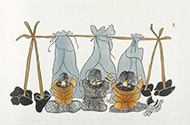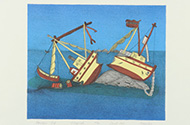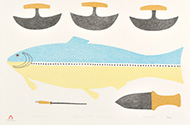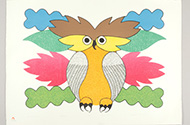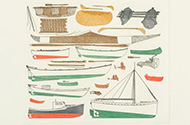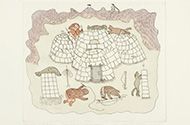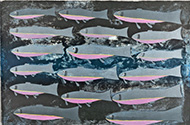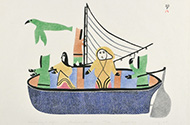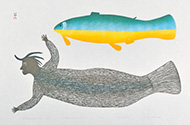1980s A Decade of Challenges
The new decade presented many challenges for the print studio in Cape Dorset. A global economic recession in the early 1980s dampened the world’s art markets. Adding to this, a number of senior artists who were regular contributors passed away, including Pitseolak Ashoona (1983), Sheokjuk Oqutaq (1982), Timothy Ottochie (1982), Eegyvudluk Ragee (1983) and Lucy Qinnuajuak (1982). As other employment opportunities became available in the community, fewer young people, it seemed, were interested in contributing drawings to the studio. Whereas in 1974 there were 20 artists represented in the annual collection, by 1985 only 10 artists were represented in the annual collection—all senior artists.
The studio made many efforts to rejuvenate local interest in the graphics program by offering a variety of new programs and continuing old ones. Terrence Ryan, the resident arts advisor, proposed an “open studio” to be held in Cape Dorset in 1986, which brought Inuit artists there from various parts of the North to learn printing techniques from established Cape Dorset and outside printmakers. This program complemented the West Baffin Eskimo Co-operative’s existing visiting artist program, which continued throughout the 1980s. The visiting artist program had been informally established years earlier to bring Southern artists to Cape Dorset to work alongside Inuit artists.
The pre-eminent stonecut and stencil printmakers of this decade included Arnasu Qudjuaju, Eegyvudluk Pootoogook, Iyola Kingwatsiak, Kiakshuk Niviaqsi, Kabubuwa Katsiya, Laisa Qudjuakjuk, Pee Mikkigak, Saggiaktok Saggiaktok and Timothy Ottochie. The chief lithographers included Pitseolak Niviaqsi, Pootoogook Qiatsuk and Audla Pudlat, while the etching and aquatint printers included Auksuali Ottochi, Kooyoo Simiga (and stonecut) and Udluriak Pudlat.
Compared with the growth years of the 1970s, when the Cape Dorset studio had at times released over 100 different prints per year, the annual collections in the 1980s grew smaller in size, numbering only 30 prints by 1989. Etching portfolios tapered off around 1984. Annual collections focused upon fewer artists, which clouded the future viability of the studio. By the close of the decade, Kananginak Pootoogook, Kenojuak Ashevak, Pitaloosie Saila, Mary Pudlat, Napachie Pootoogook and Pudlo Pudlat formed the nucleus of graphic artists furnishing drawings for the print studio.
However, several younger artists and printmakers were quietly assuming greater leadership roles behind the scenes. Pitseolak Niviaqsi, who worked alongside the visiting arts advisor and master printer Bill Ritchie in the late 1980s, began to explore a wider variety of lithographic techniques—lithographic washes, large-format stones, metallic inks and complexly overlaid colours—to enlarge the artistic possibilities of Cape Dorset graphic artists. Kavavaow Mannomee’s growing confidence as an artist and stonecut printmaker became evident in the late 1980s, as he and Qiatsuk Niviaqsi took on greater roles in the studio. By the late 1980s, graphic artists Audla Pudlat and Arnaqu Ashevak — a new addition to the studio — were contributing a fresh body of drawings to the studio’s image bank. Jimmy Manning, who started working in the studio in the 1970s, assumed greater responsibilities as manager of the studio. As Terrence Ryan presciently wrote in the 1987 catalogue, “Change is in the air....”

